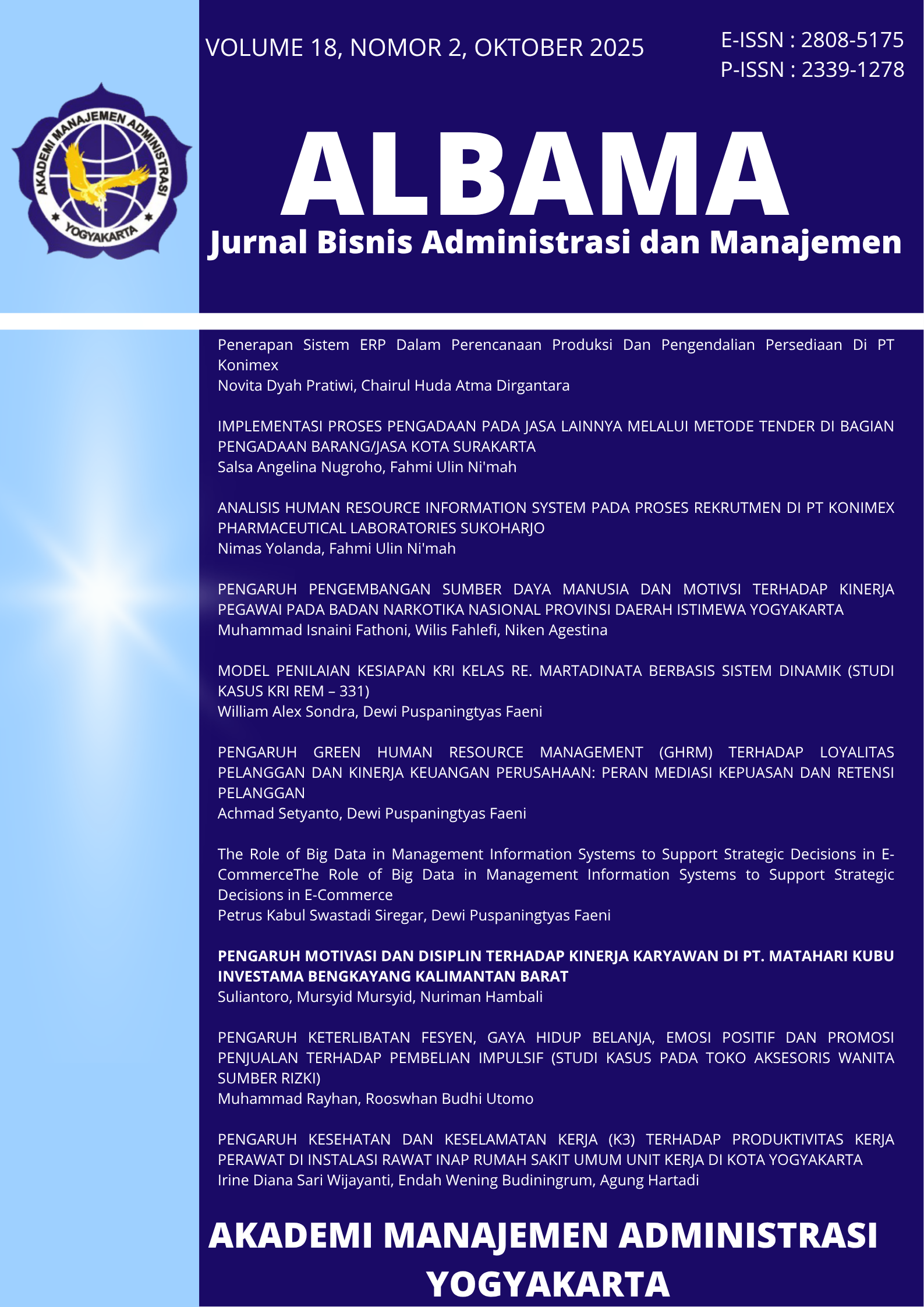MODEL PENILAIAN KESIAPAN KRI KELAS RE. MARTADINATA BERBASIS SISTEM DINAMIK (STUDI KASUS KRI REM – 331)
DOI:
https://doi.org/10.56606/albama.v18i2.329Keywords:
KRI Readiness, KRI REM-331, Dynamic SystemAbstract
To support Indonesia’s vision as a global maritime axis, this paper analyzes the
operational readiness of the KRI R.E. Martadinata-class frigate (KRI REM-331).
Utilizing a dynamic system model with a 25-year time horizon, the study evaluates
the complex interactions between four key variables: Technical, Personnel,
Logistics, and Combat Readiness. Simulation results indicate that focusing on
Technical Readiness alone increases overall readiness by an average of 3.7%,
while prioritizing Logistics Readiness yields a 2.1% increase. A combined scenario
improving both Technical and Logistics variables proved most effective, causing
an average readiness increase of 5.5%. The study, therefore, concludes that while
Technical Readiness is the single most influential variable, the most impactful
strategy for significantly enhancing KRI readiness involves an integrated approach
that simultaneously advances both technical and logistical capabilities, thereby
strengthening national maritime defense.
Downloads
References
Amelia, P., Lathifah, A., & Yasa, I. A. (2021). Analysis of the impact of maritime
sector development in supporting Indonesian Navy ship operations.
ScienceDirect, 197, 317 325.
Ayawaila, M. R., & Isarisnawan, M. (2021). Analisis kesiapan personel Korps
Marinir dalam penugasan operasi pemeliharaan perdamaian dunia dengan
menggunakan metode Soft System Methodology.
Christopher, M. (2016). Logistics and supply chain management: logistics & supply
chain management. Pearson UK.
Davahli, M. R., Karwowski, W., & Taiar, R. (2020). A system dynamics simulation
applied to healthcare: A systematic review. International journal of
environmental research and public health, 17(16), 5741.
Efendi, B., Bastari, A., & Suharyo, O. S. (2021). Strategies for capability
improvement of Fasharkan Surabaya in supporting Indonesian warship
operation readiness. Journal of ASRO, 12, 117–126. International
Faeni, D. P. (2024). Green practices and employees’ performance: The mediating
roles of green human resources management policies and knowledge
development. Journal of Infrastructure, Policy and Development, 8(8),
https://doi.org/10.24294-/jipd.v8i8.4924
Faeni, D. P. (2024). SERVQUAL measures: Indonesian government healthcare
(BPJS) from a human resource perspective. Journal of Infrastructure, Policy
and Development, 8(2). https://doi.org/10.24294/jipd.v8i2.2271
Faeni, D. P., Faeni, P. F., Basrowi., Sungkono. (2025). Green HRM for sustainable
aviation: An integration evaluation using PLS-SEM and fsQCA.
Environmental Challenges, Vol 20, 101232, ISSN 2667-0100,
https://doi.org/10.1016/j.envc.2025.101232Hartanto,
Faeni, D. P., Oktaviani, R. F., Riyadh, H. A., Faeni, R. P., & Beshr, B. A. H. (2025).
Green Human Resource Management and Sustainable Practices onCorporate Reputation and Employee Well-being: A Model for Indonesia’s
F&B Industry. Environmental Challenges, 101082.
https://doi.org/10.1016/j.envc.2025.101082
Faeni, D. P., Puspitaningtyas Faeni, R., Alden Riyadh, H., & Yuliansyah, Y. (2023).
The COVID-19 pandemic impact on the global tourism industry SMEs: a
human capital development perspective. Review of International Business
and Strategy, 33(2), 317–327. https://doi.org/10.1108/RIBS-08-2021-0116
Faeni, D.P., Oktaviani, R.F., Riyadh, H.A., Faeni, R.P. and Beshr, B.A.H. (2025),
Green Human Resource Management (GHRM) and Corporate Social
Responsibility (CSR) in Reducing Carbon Emissions for Sustainable
Practices. Qual Manage., 34: e70048. https://doi.org/10.1002/tqem.70048
Iskandar, R., Febri, B., & Samiaji, R. (2020). The effectiveness using the
Indonesian warship Parchim class in order to support the maritime security
operations at Natuna Sea.
Naugle, A., Langarudi, S., & Clancy, T. (2023). What is System Dynamics
Modeling? Defining Characteristics and the Opportunities they Create.
arXiv preprint arXiv:2307.11801.
Prasetia, H. (2021). Model penilaian kesiapan KRI dalam mendukung tugas pokok
TNI AL.
Prasetio, E. A., Syarief, R., Arkeman, Y., & Santoso, A. I. (2021). System dynamic
and simulation of business model innovation. Journal of Open Innovation:
Technology, Market, and Complexity, 7(219), 1–17.
Primeka, F. (2019). Analisa pemilihan rudal SAM (Surface to Air Missile) KRI
Kelas RE. Martadinata menggunakan metode ANP dan Topsis.
PUM-7.01.004. (2014). Buku petunjuk teknis penilaian kelaikan materiil KRI.
PUM-7.08.002. (2014). Buku petunjuk teknis penentuan usia KRI dan KAL di
lingkungan TNI Angkatan Laut.
Pushidrosal. (2018). Peta Pulau Indonesia. Jakarta: Pushidrosal.
Simamora, H. (2020). Manajemen sumber daya manusia. Yogyakarta: Sekolah
Tinggi Ilmu Manajemen YKPN.
Vitasek, K. (2013). CSCMP supply chain management definitions and glossary.
Council of Supply Chain Management Professionals.
Wira, I. P. (2021). Analisa kemampuan Squadron 800 Wing Udara II sebagai satuan
patroli udara maritim dalam mendukung operasi Kamla wilayah kerja
Koarmada II.
Y. A. (2016). Manajemen logistik dalam meningkatkan kesiapan tempur alutsista
TNI AL.
Downloads
Published
How to Cite
Issue
Section
License
Copyright (c) 2025 William Alex Sondra, Dewi Puspaningtyas Faeni

This work is licensed under a Creative Commons Attribution 4.0 International License.




.jpg)
